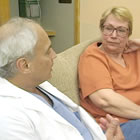|
Scores of healthcare professionals in a variety of disciplines, from physicians to cardiovascular interventionalists, surgeons, general internists, imaging specialists, nurses, and pharmacists worked for several years writing and revising these guidelines, which are endorsed and issued by The American College of Cardiology (ACC)/American Heart Association (AHA) Task Force on Practice Guidelines, along with the American College of Physicians (ACP), American Association for Thoracic Surgery (AATS), Preventive Cardiovascular Nurses Association (PCNA), Society for Cardiovascular Angiography and Interventions (SCAI), and The Society of Thoracic Surgeons (STS). In a press release, the American College of Cardiology stated: "Ischemic heart disease affects nearly 10 million Americans, and remains the leading cause of death among US adults. This condition is most often due to a build-up of fat or plaque in the heart's arteries that can reduce critical blood flow to the heart and often other parts of the body as well. With appropriate medical care, this condition remains stable in the vast majority of patients with few or no symptoms and the ability to pursue normal activities without limitations. Still, ongoing medical therapy and careful monitoring are essential to prevent heart attack and untimely death and should be based on strong scientific evidence and individual patient preferences." The new guidelines amplify the 2002 recommendations in terms of medical management being the first line of treatment. Now dubbed Guideline-Directed Medical Therapy (GDMT), the authors point to the advances made in medical management, the outcomes of various clinical trials such as COURAGE and BARI 2D showing medical management to be similar to more invasive strategies in stable patient and to a host of risk-factor modifications that must be undertaken by the patient. Patient Involvement at the Center An entire section of the guidelines is titled, "Vital Importance of Involvement by an Informed Patient", and it's a Class I recommendation. The introduction to this section states, "Choices about diagnostic and therapeutic options should be made through a process of shared decision making involving the patient and provider, with the provider explaining information about risks, benefits, and costs to the patient." There are many pages of documentation of discussion as to how patients and physicians can achieve these goals, although success in this area depends on many outside factors, many of which are not universally in place, such as patient education programs and groups, training for physicians on patient-practitioner communication skills, and a major impediment: money. A summation of this issue states, "...how to best provide cost-effective educational strategies remains a challenge in today's healthcare environment. The lack of payment for these activities remains an important barrier." Emphasis on Medical Therapy Julius M. Gardin, MD, cardiologist, Professor and Chair, Department of Medicine at Hackensack University Medical Center's and Vice Chair of the writing committee, adds, "Overall, there is a misperception that somehow opening up and stenting an artery saves lives for patients with stable disease; however, in the majority of these cases there is no evidence from any study that this procedure prolongs life. The percent narrowing in and of itself isn't as important as what it [the blockage] is doing downstream in terms of the heart getting -- or not getting -- enough nutrients. For this reason, we emphasize testing to show this, whether it's through some of the non-invasive imaging tests or in the cath lab." Indeed, in the past decade, new tools and measurement technologies have come into practice, tools which can aid in determining when a more invasive strategy may be beneficial. For example, fractional flow reserve (FFR) is singled out as a functional measurement modality that can be used, in addition to angiography, to decide on a more invasive treatment strategy. In fact in the guideline, FFR actually trumps angiography: "...angiography in isolation provides only anatomic data and is not a reliable indicator of the functional significance of a given coronary stenosis unless a technique such as FFR...is used to provide information about the physiological significance of an anatomic stenosis." Importantly, the guideline specifically recommends only performing revascularization of an artery with a blockage of 70% or more, as measured by angiography, or an FFR of less than or equal to 0.80 (i.e. blood flow that is impeded by 20% or more). When such testing does show evidence of a severe blockage in patients on optimal medical therapy, and they are limited by their chest pain, coronary stenting or bypass surgery provides relief faster and at least as effectively as medicines. Of course, back to the concept of patient preference, the guideline states that, in the case of stable symptoms, it is the patients who should have the final say in how their chest pain is treated. Guideline Does Not Apply to Unstable or Emergency Patients Nevertheless, there will be much in these guidelines that will be debated. And new trials will be done and published that may modify some of these recommendations. Several, in fact, have already been published since the guidelines were finalized: the FREEDOM trial had significant findings about whether surgery or PCI should be done in diabetic patients with multivessel disease; FAME 2 questioned whether patients with clearly ischemic blockages via FFR should be placed on medical therapy alone, or offered PCI. The 8,000 patient ISCHEMIA trial will no doubt have important findings, although those results are several years away. And the rate of advancement in genomic research is such that entirely new methods of diagnosis may be found in the interim. Reported by Burt Cohen, December 5, 2012 |

